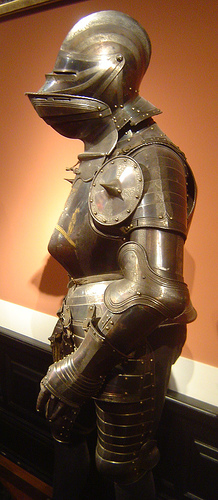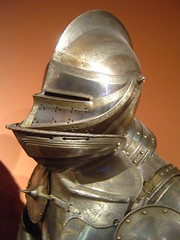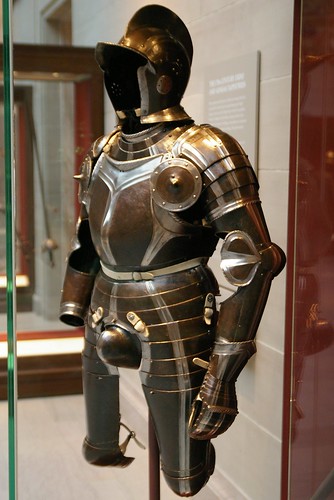| Author |
Message |
|
Josh MacNeil
Location: Massachusetts, USA Joined: 23 Jul 2008
Posts: 197
|
 Posted: Sat 09 Jan, 2010 8:16 pm Post subject: Use of outdated armor...? Posted: Sat 09 Jan, 2010 8:16 pm Post subject: Use of outdated armor...? |
 |
|
|
I'm not sure if this has been discussed before. My thread search turned up pretty much nothing. I was wondering how common it was for lower income soldiers/men at arms (from let's say 14th Century on) to utilize older armor from eras past. I know that lower classes in the middle ages were generally slower in their adoption of the latest arms and armor innovations. I also know that it was not uncommon for an old sword that was well kept to be re-hilted and reused for as long as it could be maintained. So what about well kept pieces of armor? I've learned from previous research that, for obvious reasons, a serviceable helm would have been high on the priority list for a soldier of any income. Would it have been plausible for a low income soldier to utilize a 100 or 200 year old (or more) helm so long as it was well kept?
|
|
   |
 |
|
Matthew Amt
|
 Posted: Sat 09 Jan, 2010 8:35 pm Post subject: Posted: Sat 09 Jan, 2010 8:35 pm Post subject: |
 |
|
Well, I've seen pieces that have been "modernized" or modified in some way. There is a 2nd century AD Roman helmet which at some point had its neckguard cut off and holes punched around the rim, something the Romans didn't do until about the 4th century or so. The Higgins Armory Museum has a 17th century breastplate which was reinforced inside with most of a 16th century breastplate! I have heard that old pieces of plate armor could be cut up to make brigandines, etc.
But just using outdated stuff was probably not uncommon. However, I wouldn't expect to see too many common infantrymen wearing outdated *noblemens'* armor from a couple generations earlier, simply because there would not have been that much of it to go around (10 times as many commoners as nobles, I mean!). Armored commoners would mostly be wearing munition armor, even if it wasn't new. But I'm sure someone can come up with documentation of old knights' armor being sold off on the second-hand market.
Matthew
|
|
   |
 |
|
P. Cha
|
 Posted: Sat 09 Jan, 2010 9:21 pm Post subject: Posted: Sat 09 Jan, 2010 9:21 pm Post subject: |
 |
|
|
The book the last duel specifically says that one of the combatants had outdated armor due to being financially hampered due to some bad campaigns. And he was a noble.
|
|
  |
 |
Alan Schiff
Industry Professional

|
 Posted: Sat 09 Jan, 2010 11:31 pm Post subject: Posted: Sat 09 Jan, 2010 11:31 pm Post subject: |
 |
|
I don't have a copy on hand right now, but if I recall correctly in Arms and Armor of the Medieval Knight it mentions that towards the end of the 14th century and beginning of the 15th century, as plate became more prevalent, many lesser nobles and men at arms were still using older style mail protection, even on arms and legs, because of the cost of plate. I have also read in other sources that specific areas known to be less wealthy, such as Scotland and Ireland, generally were years behind in arms and armor technology, so anyone not wealthy enough to import arms or go abroad to shop were stuck with older style armor.
Hope that helps,
Alan
|
|
   |
 |
|
David Evans
|
 Posted: Sun 10 Jan, 2010 1:24 am Post subject: Old style armour Posted: Sun 10 Jan, 2010 1:24 am Post subject: Old style armour |
 |
|
There's considerable evidence to suggest that the Elizabethan Trained Bands were prone to hanging onto old armour. Muster returns from the 1580's and 1590's constantly list "Alamain Rivet" as armour put forward to fulfill a persons requirement under law.
Alamain Rivet was bought in vast quanties by Henry VIII so by the 1580's most of the remaining armour are about 60 years old.
There are also a few pieces of 16th Century armour surviving that were modified in the early 1640's at the start of the British Civil Wars.
|
|
  |
 |
Alex Hoogstraten

Location: The netherlands Joined: 05 Jan 2010
Posts: 20
|
 Posted: Sun 10 Jan, 2010 1:40 am Post subject: Posted: Sun 10 Jan, 2010 1:40 am Post subject: |
 |
|
We had had this discussion in or 14th century group.
We are mid 14th century. Old fashioned for us us would be hauberks and some older types of basinets. But we are also Dutch mercenaries from Holland, Brabant and Flanders, one of the more wealthier parts of europe. Fashion spreads faster there than say some parts in South Eastern France were there are images of this period still showing kiteshields, thou in most parts those are not show since 1250.
But also, Equipment like coat_of_Plates or wisby gauntlets, or for a great part out of leather and linen etc. These things wear out. For the same price one would rather buy new or refashion the old.
For common soldiers the equipment would be cruder and would probably not last very long. City militia's would often lend equipment for the city for a small price. depending the wealth of the city the equipment would fashioned or old fashion. City elites and wealthy noblemen would probably make sure their equipment would be up to date.
Our group tries to maintain equipment that was used 50 years before. The difference in equipment would simply be too great if we would push it further.
www.cranenburgh.nl
|
|
  |
 |
Boris R.

|
 Posted: Sun 10 Jan, 2010 2:30 am Post subject: Posted: Sun 10 Jan, 2010 2:30 am Post subject: |
 |
|
also it was not uncommon for the medieval/renaissance soldier (and mercs especially) to pillage the vanquished for armour parts, its best seen in central europe (italian city states) and balkans where the perpetual contact with Ottomans for instance also brought about acceptance of the eastern sword (sabers) and helmet (zischagge) types. so the armours on majority would be of more-less mottled origin
Never take life seriously. Nobody gets out alive anyway.
|
|
  |
 |
|
Allan Senefelder
Industry Professional
|
 Posted: Sun 10 Jan, 2010 6:03 am Post subject: Posted: Sun 10 Jan, 2010 6:03 am Post subject: |
 |
|
|
In the book Armor from Medieval Rhodes the authors track down and document much of the contents of the fortress armoury which was sold off by auction houses in the later 19th and early 20 th centuries. The fortress fell to the turks in 1522. The oldest pieces documented in the book from the fortress armoury are several armets and breast plates dating from the 1430s and 40s making them nearly 100 years old when the fortress fell.
|
|
   |
 |
Hisham Gaballa

|
 Posted: Sun 10 Jan, 2010 7:44 am Post subject: Posted: Sun 10 Jan, 2010 7:44 am Post subject: |
 |
|
|
I suspect that more specialised pieces of noble armour, would be scrapped and reforged into new pieces; for example I doubt that a mid-14th century soldier would have had much use for a mid-13th century great helm. A piece like that would have probably just been reforged into a totally new piece of armour.
|
|
  |
 |
|
Adam Bodorics
Industry Professional
|
 Posted: Sun 10 Jan, 2010 10:55 am Post subject: Posted: Sun 10 Jan, 2010 10:55 am Post subject: |
 |
|
Also it might be worth mentioning that for example Heinrich von Rantzau had a bevor for his harness, which is dated to 1560. The bevor fits perfectly to the breastplate and the decorations are coherent, so it's likely an original part to it.
So it seems that even wealthy guys had the idea of using "outdated" stuff - I don't really see bevors after 1510-15, only wrappers and buffes, and both are different than Rantzau's.
Oh, and some tappelbrusts show some similarity to the pointed version of the kastenbrust, so it's a case of "grandpa's stuff is fashionable again with a bit of tampering". And I recall reading about a "viking" blade remounted to be a katzbalger.
...
And some armed personnel today use a handgun designed 99 years ago with mostly cosmetic/comfort modifications... 
 Attachment: 85.16 KB Attachment: 85.16 KB

|
|
  |
 |
Chad Arnow
myArmoury Team


|
 Posted: Sun 10 Jan, 2010 12:52 pm Post subject: Posted: Sun 10 Jan, 2010 12:52 pm Post subject: |
 |
|
| Adam Bodorics wrote: | Also it might be worth mentioning that for example Heinrich von Rantzau had a bevor for his harness, which is dated to 1560. The bevor fits perfectly to the breastplate and the decorations are coherent, so it's likely an original part to it.
|
That looks more like a buffe seen with burgonets than a true bevor (usually associated with sallets). If it's a bolt-on piece, it could simply be a reinforcing piece used for some forms of joust like we see in a number of surviving great garnitures.

ChadA
http://chadarnow.com/
|
|
    |
 |
Adam D. Kent-Isaac

|
 Posted: Sun 10 Jan, 2010 2:09 pm Post subject: Posted: Sun 10 Jan, 2010 2:09 pm Post subject: |
 |
|
Yes, you can see that it has multiple lames and probably is articulated to fold down the way buffes for burgonets did. It seems kind of like a grandguard from an Augsburg or Greenwich garniture, though it is also smaller and different. It is definitely a unique piece, though, being worn over an armet as it is, giving the armour a duck-billed sort of appearance. That is definitely an armour with "personality."
Heinrich Rantzau was an interesting guy. He was the governor of Holstein and a big advocate of Humanism, and an astrologer. He's not really remembered as a fighting man; that armour is probably a tournament piece made for him when he was younger. His father was a military commander who served the Danish king.
Pastime With Good Company
|
|
  |
 |
Daniel Staberg

|
 Posted: Sun 10 Jan, 2010 2:24 pm Post subject: Posted: Sun 10 Jan, 2010 2:24 pm Post subject: |
 |
|

Paul Donsteins drawing shows Swedish yeomen wearing bascinets, sallets and kettlehats in the early 16th Century.
Likewise there are early 16th Century Swiss Chronicles which show a few men in mail shirt and kettlehat mixed in with men in much more up to date and fashionable equipment.
|
|
  |
 |
Adam D. Kent-Isaac

|
 Posted: Sun 10 Jan, 2010 5:35 pm Post subject: Posted: Sun 10 Jan, 2010 5:35 pm Post subject: |
 |
|
Actually, that armour for Rantzau is anachronistic/odd in some other ways too. Aside from the bevor or buffe over the helmet there's also the helmet itself, which is so sharply pointed that it almost has the shape of a houndskull visor. I haven't really seen any other armets with such a pronounced point to the upper bevor. There's also the fact that it has besagews. Were besagews really in common use by 1560?

Pastime With Good Company
|
|
  |
 |
|
Eric Forster
|
 Posted: Sat 21 Aug, 2010 11:52 am Post subject: Besagews: mid-sixteenth century Posted: Sat 21 Aug, 2010 11:52 am Post subject: Besagews: mid-sixteenth century |
 |
|
Hi Adam,
Here's a shot of a black & white suit, dated 1540-1550, at the Cleveland Museum, complete with besagews, so 1560 seems not that late a date to sport them, particularly with an Almain collar.
I find the leg defenses to be interesting on this black & white: having tassets attached directly to cuisses, rather than the knee-length tassets of so many black & whites.
Cheers
|
|
  |
 |
|
Eric Forster
|
 Posted: Sat 21 Aug, 2010 11:57 am Post subject: Posted: Sat 21 Aug, 2010 11:57 am Post subject: |
 |
|
Ah, my file is just too large to upload (1.9 MB), so for anyone who is interested in seeing this, just PM me, or drop me a line at eforster1 at gmail dot com.
Cheers
|
|
  |
 |
Randall Moffett

|
 Posted: Sat 21 Aug, 2010 5:45 pm Post subject: Posted: Sat 21 Aug, 2010 5:45 pm Post subject: |
 |
|
There sure is... in fact there is a great deal of info on this for the period you are looking at. Check out the register of Datani, the italian arms and armour merchant of the 14th century. The guy has a full scale economy of selling old arms and armour
The York Archbiz. probate inventories are full of older armour and arms still in use some score or half a century later.
RPM.
|
|
  |
 |
Jean Thibodeau

|
 Posted: Sat 21 Aug, 2010 6:34 pm Post subject: Posted: Sat 21 Aug, 2010 6:34 pm Post subject: |
 |
|
| Randall Moffett wrote: | There sure is... in fact there is a great deal of info on this for the period you are looking at. Check out the register of Datani, the italian arms and armour merchant of the 14th century. The guy has a full scale economy of selling old arms and armour
The York Archbiz. probate inventories are full of older armour and arms still in use some score or half a century later.
RPM. |
I think the more " strict " living history people should keep the above in mind when they dismiss some odd mixtures of older armour that where probably very common or at least more common than we assume ?
There are certainly reasonable limits like not seeing old Roman armour or arms used 5 centuries past their best before date but an old but still functional sword might still be very much in use 50 to 100 years past the period we normally associate with it. Also when one gets to later periods with the use of official military uniforms and standard official kit one would see less personal choice in personal kit, but in earlier periods there wasn't an official service sword or armour. and there would be more room for odd or eccentric anachronistic mix and matching of kit.
Now with the very rich or high nobles keeping up with fashion would certainly influence how late they might still use some old piece of armour or weapon: But then many old blades where remounted in more current styles of hilts if the blade had value as being of superior quality and in maybe being prized as a family heirloom ?
And there is the " hand me downs " of out of fashion armour with the elites going down the food chain with the older pieces still being used by close retainers ( last year's model   ) and older still being passed along to common soldiers and militias, mercenaries and civilians. ) and older still being passed along to common soldiers and militias, mercenaries and civilians.
You can easily give up your freedom. You have to fight hard to get it back!
|
|
  |
 |
Adam D. Kent-Isaac

|
 Posted: Sat 21 Aug, 2010 7:11 pm Post subject: Re: Besagews: mid-sixteenth century Posted: Sat 21 Aug, 2010 7:11 pm Post subject: Re: Besagews: mid-sixteenth century |
 |
|
| Eric Forster wrote: | Hi Adam,
Here's a shot of a black & white suit, dated 1540-1550, at the Cleveland Museum, complete with besagews, so 1560 seems not that late a date to sport them, particularly with an Almain collar.
I find the leg defenses to be interesting on this black & white: having tassets attached directly to cuisses, rather than the knee-length tassets of so many black & whites.
Cheers |
I assume you're talking about this, and yes, it is quite boss!

Pastime With Good Company
|
|
  |
 |
James Arlen Gillaspie
Industry Professional

Location: upstate NY Joined: 10 Nov 2005
Posts: 587
|
 Posted: Sun 22 Aug, 2010 12:39 pm Post subject: Posted: Sun 22 Aug, 2010 12:39 pm Post subject: |
 |
|
Such bevors as that on the von Rantzau harness are not that rare, but I am more used to seeing them with burgonets. I suspect strongly that the von Rantzau had a burgonet at one time. This is A499, also in Vienna.
 Attachment: 208.59 KB Attachment: 208.59 KB
[ Download ]
jamesarlen.com
|
|
   |
 |
|
|

